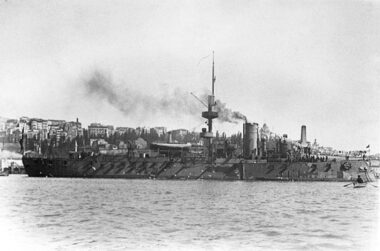| Type | Barbette battery ironclad | Hull | Iron |
| Displacement | 4687 tonnes | Engines | 1 horizontal compound expansion, La Seyne |
| Length | 83.0 m | Machinery | Steam, 1 shaft |
| Beam | 16.0 m | Speed | 9 kts |
| Draught | 6.5 m | Complement | 350 |
| Armament | 3 x 150 mm L/40 quick firing guns, Krupp | 7 x 120 mm L/40 quick firing guns, Krupp | 6 x 57 mm L/40 quick firing guns, Krupp | 2 x 37 mm L/40 quick firing guns, Krupp | ||
 Asar-ı Tevfik, translating to "God's Favour" in Ottoman Turkish, was a formidable ironclad warship commissioned by the Ottoman Navy in the 1860s, and it stood as the sole vessel of its class. It was ordered in 1865 by the government of Egypt as İbrahimiye and laid down two years later at the French Société Nouvelle des Forges et Chantiers de la Méditerranée shipyard in La Seyne. The ship was launched in 1868 and completed by 1869 for sea trials. In the meantime, Egypt had transitioned from a state directly ruled by the Ottoman government to the autonomous Khedivate of Egypt, and on 29 August 1868 the Khedivate transferred the ship to the Ottoman Navy. She was commissioned as Asar-ı Tevfik in 1870.
Asar-ı Tevfik, translating to "God's Favour" in Ottoman Turkish, was a formidable ironclad warship commissioned by the Ottoman Navy in the 1860s, and it stood as the sole vessel of its class. It was ordered in 1865 by the government of Egypt as İbrahimiye and laid down two years later at the French Société Nouvelle des Forges et Chantiers de la Méditerranée shipyard in La Seyne. The ship was launched in 1868 and completed by 1869 for sea trials. In the meantime, Egypt had transitioned from a state directly ruled by the Ottoman government to the autonomous Khedivate of Egypt, and on 29 August 1868 the Khedivate transferred the ship to the Ottoman Navy. She was commissioned as Asar-ı Tevfik in 1870.
Asar-ı Tevfik was refitted twice; 1890-1892 in Istanbul and 1900-1907 in Kiel, undergoing a substantial transformation in Germany, where her weaponry received a modern upgrade. The older guns were replaced with a new battery consisting of quick-firing guns, aligning her with the evolving technologies of naval warfare.
For over four decades, Asar-ı Tevfik faithfully served in the Ottoman fleet, witnessing and participating in historic conflicts. Notably, she played a role in two major wars—the Russo-Turkish War of 1877–1878 and the First Balkan War in 1913. During the former, she displayed her resilience when faced with Russian torpedo boats' attack, sustaining torpedo damage below the water level, which was repaired at Batumi.
One of her most memorable engagements was the abortive Battle of Elli in December 1912 during the First Balkan War, where she joined the Ottoman fleet in a battle against the Greek Navy. However, her fate took a tragic turn in February 1913 while operating against Bulgarian positions. Grounded and vulnerable, Asar-ı Tevfik fell victim to Bulgarian field artillery, exacerbated by adverse sea conditions, leading to her ultimate destruction on 11 February 1913.
![]()



